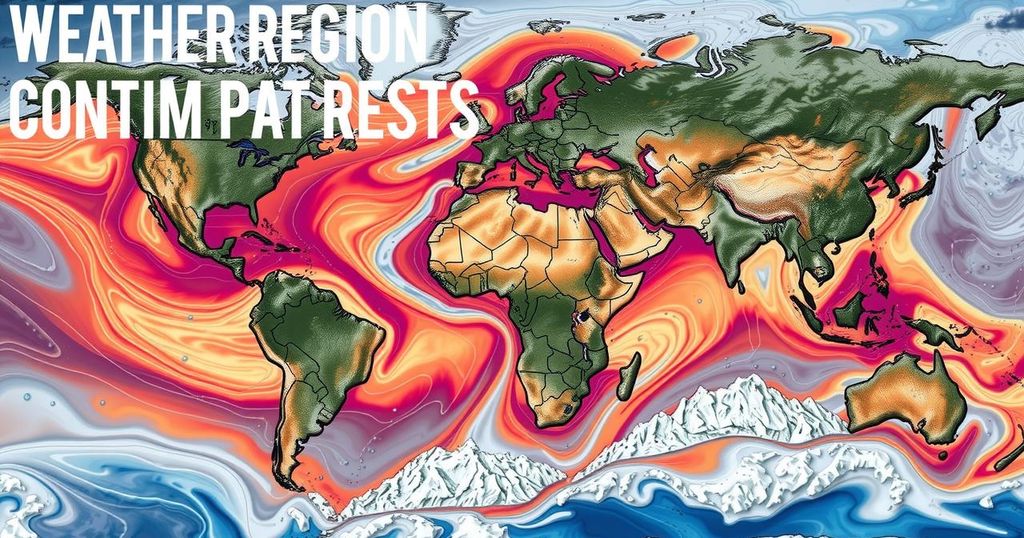The onset of 2025 brought severe weather events including destructive winds and record-breaking heat, linked to human-caused climate change, with 2024 marking the hottest year recorded. Advances in scientific methodologies have improved the ability to attribute specific weather events to climate change. While not every weather anomaly can be directly connected, the overall trend indicates a significant influence of increasing global temperatures on extreme weather patterns.
The year 2025 commenced with significant weather events, including hurricane-force winds and unprecedented wildfires in Southern California, alongside severe winter storms affecting the Mid-Atlantic and Southern regions. Concurrently, it was reported by leading meteorological scientists that 2024 was recorded as the hottest year in human history due to human-induced climate change. While historically scientists hesitated to directly attribute isolated weather anomalies to climate change, advancements in research over the past decade have enhanced the capacity to identify the effects of climate change on weather phenomena, including extreme heat waves, hurricanes, and wildfires.
Not all weather patterns can be directly linked to climate change; however, the continual rise in global temperatures has become increasingly evident in many extreme weather occurrences. Justin Mankin, a climate scientist at Dartmouth College, articulates that the trends in climate are creating unprecedented weather patterns. The distinction between climate and weather is often summarized by a saying among scientists: climate is what one prepares for, while weather is what one experiences on a day-to-day basis. Danielle Touma, a climate scientist at the University of Texas at Austin, underscores this distinction by drawing an analogy between climate and the clothing one chooses to wear based on daily weather conditions.
Climate is generally defined by a thirty-year average of weather data, meaning that unusual weather events contribute to this average but do not dominate it, as noted by Deepti Singh, a climate scientist at Washington State University. The impacts of human-induced climate change are becoming increasingly detectable in daily weather; since the mid-1800s, the Earth’s temperature has risen approximately 1.3 degrees Celsius due to the extensive utilization of fossil fuels, leading to significant consequences for weather patterns worldwide.
Singh points out that this gradual increase in temperature affects daily weather in subtle, yet profound, ways, even if these changes are not immediately obvious. For instance, states like Michigan and Ohio are now experiencing over a week less of freezing conditions due to climate change, alongside a significant increase in the frequency of heat waves across the United States since the 1960s. The ongoing changes in climate disrupt intricate atmospheric and oceanic processes, occasionally yielding extreme weather that exceeds prior experiences. The Pacific Northwest’s deadly heat wave of 2021 serves as a substantial example where climate change heightened peak temperatures while creating unprecedented atmospheric conditions.
Recent scientific advancements, including innovative “detection” and “attribution” methodologies, have established how to evaluate the influence of human-induced climate change on weather phenomena. These techniques involve utilizing climate models to simulate weather conditions in the absence of fossil fuel emissions. Comparisons reveal that significant weather events, such as Hurricane Helene, exhibited rainfall intensity that was 10% higher than it would have been without human-caused climate change, attesting to the increased likelihood of such events under current climate conditions. Mankin likens this analytical approach to clinical trials, where one assesses the effects of a treatment by comparing it against a control group.
The relationship between climate change and weather is an increasingly prominent topic within scientific research and public discourse. As global temperatures continue to rise due to anthropogenic activities, researchers are working diligently to understand how these changes affect weather patterns. Historically, attributing specific weather events to climate change has been fraught with uncertainty, but advancements in climate science have refined the ability to connect these phenomena through innovative analytical techniques. This article explores recent weather extremes while elucidating the connections to climate change impacts, with a focus on the implications for future weather variability.
In conclusion, the analysis of contemporary weather patterns reveals a complex interplay between climate change and individual weather events. While not all fluctuations can be traced directly to climate change, the considerable warming of the planet has been shown to exert an influence on numerous extreme weather occurrences. As researchers continue to refine methodologies for attributing weather changes to anthropogenic factors, the understanding of these connections is likely to evolve, highlighting the urgency of addressing climate change to mitigate further extreme weather impacts in the future.
Original Source: www.southcarolinapublicradio.org






